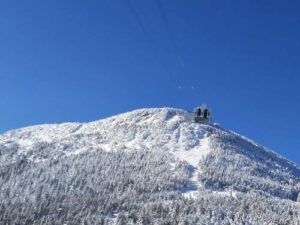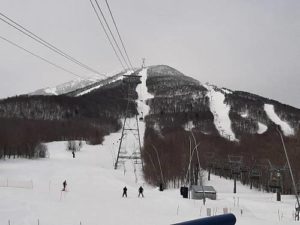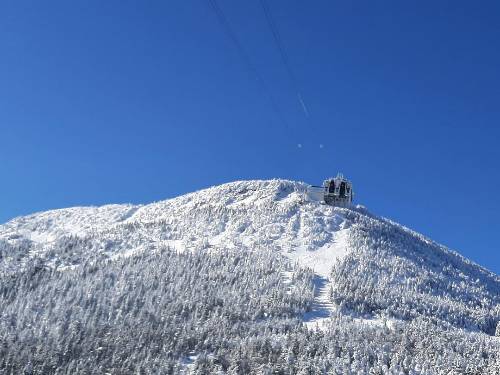
[Editor’s Note: Hooray for winter! Everywhere of note is making snow, and to celebrate the start of the season, our Border War Series is back. One man goes to 20+ places in New Hampshire and 20+ in Vermont and tells you once and for all who wins.
This week we’ll be posting stories about Jay Peak! So let’s get right to it. It”s shred-tastic!]
Border War! Vermont vs. New Hampshire Skiing Part 10 – Jay Peak
—by Jay Flemma—
JAY, VT – Shortly before I took the Jay Peak assignment, I was lamenting about how the only thing I had been lacking for some time was a truly unconquerable, scare-you-to-death, criminally-narrow, rocky, cliff jump-studded skier-eater of a double black diamond. I wanted the final examination of the expert athlete. But ever since the Cannon Mountain trip in 2019, even though I’d seen a steady of diet of great places, there wasn’t that otherworldly, nigh unconquerable fire-breathing dragon of a challenge. I still wanted…needed…to test myself to the utmost.
Well, be careful what you wish for, because you might just get it.
I was well aware of Jay Peak’s formidable reputation as a place where even the most skilled expert skiers come to test their mettle to the utmost. What I was not prepared for was Old Man Winter winding up to hit me over the head with a sandbag from behind before I got there, turning my assignment at what otherwise was one of America’s greatest winter sports paradises into a semi-suicide mission.
So cut to the afternoon of Day 1 of my two-day sojourn to Vermont’s Northeast Kingdom and the fabled Jay, and there I am in one of the deepest ends of the pool: something called 601. It’s an old power line turned ski run, slim as a supermodel, steeply pitched for its entire 1,100-foot descent with woods so thick, they could have filmed Evil Dead 2 there, and the whole run bisected longitudinally into a left side and right side. The left is anywhere from eight to 12 feet higher than the left, so forget about traversing. You’ve got one lane to maneuver in, and it’s a long, bumpy, rocky, hair-raising, nerve shredding, vertigo-inducing ride down.
And so minutes into this bare-knuckle brawl of a descent into one of skiing’s proper rejoinders to a level of Hell in Dante’s Inferno, a guy in an A-basin jacket paused to catch his breath, looked at me, and said, “And this is why we don’t ski the east…”
I just replied, “This is why WE DO ski the east!!!” And grinned ear to ear as I dropped into the next glorious cascade, bouncing like the pinball of the Skiing Gods.

THE REAL BEAST OF THE EAST?
Everyone who rags on east coast skiing needs to have a nice hot cup of CHECK YOURSELF, because Jay Peak has everything you could wish from any alpine venue anywhere and can stand rightfully and proudly shoulder to shoulder with any of America’s greatest winter sports locations, both in terms of grandeur and difficulty. World class terrain, deep, plentiful pow like you dream about, majestic sweeping vistas, ferocious, relentless, nigh indominable trails and glades, and the longest winter season in the east all combine to give mighty Jay an inimitable character.
Jay Peak is so difficult – and rightfully proud of that fact – that they don’t even have a double black distinction on the trail map. What’s the point? How many wouldn’t be double black? Two? Take Mad River Glen and almost double it in size, and you have Jay Peak. Sugarbush may have Castlerock, Stowe may have the Front Four, and Killington has Outer Limits, but none of them have such breadth and depth of difficulty across the trail map and beyond as Jay Peak does.
They also don’t have the Jay Cloud.
“Jay gets the best snow in Vermont year after year,” boasted one-time local Danielle Bliss, a seasoned snowboarder who once called the Vermont’s Northeast Kingdom home. “The Jay Cloud settles in, sometimes seemingly out of nowhere, and just dumps and dumps and dumps. There’s nothing around it for miles, so Jay gets the most snow year in and year out.”
Bliss is absolutely right. Most weather systems come to Jay from the northwest, so there tends to be an updraft of trade winds once it hits the mountain. Moreover, much like any isolated mountain on the furthest edge of a range, Jay Peak can sometimes make its own weather systems, and storms have been known to brew suddenly over Jay from an otherwise clear sky. So when the weather report says three inches of snow, Jay likely gets six to eight.
The northernmost pin in Vermont’s winter map, before Indy Pass made, perhaps, the most brilliant scoop in multi-pass history, Jay was relatively obscure: known more by locals and well-travelled winter sports intelligentsia than the general public, spoken of in holy whispers by locals and those in the know. Even Jay’s interim acting CEO, Steven Wright, once lamented in print that Jay’s remote location worked against it.
If you come from the east, you pass Gunstock, Sunapee, Waterville, Loon and Cannon before you finally get to lonely Jay Peak, just 12 miles from the Canadian border. If you come from the west, you pass Killington, Sugarbush, Mad River Glen, Stowe, and Smuggler’s Notch. If you come from the south, you pass Jiminy, Mt. Snow, Stratton, Magic, Killington, Sugarbush, Mad River Glen, Stowe, and Smuggs.
Sheer convenience of the other resorts and tiredness from driving (laziness?) may have been Jay Peak’s greatest enemy for many years.
That is at least until Ariel Quiros came to town, and unquestionably became Jay’s greatest enemy, as well as one of winter sports’ most despicable scoundrels, but we’ll review those events in another chapter of this story. [Editor’s Note: Quiros sits in jail for a massive Ponzi-like fraud scheme that bilked the entire Northeast Kingdom and hundreds of investors out of hundreds of millions of dollars to fund a lavish personal lifestyle. Our story on what is known as the EB-5 scandal is coming soon.]
Does Jay get less traffic than the other resorts? Yes – you pass a lot of superb places along the way. Does it deserve more accolades and recognition, absolutely. Those who make the trek to 44 degrees 55 minutes North, 72 degrees, 31 minutes West are rewarded with all the idyllic majesty of Vermont’s Northeast Kingdom, one of the few truly wild frontiers still remaining in this country. Some of the eastern hemisphere’s most ancient forests – noble evergreens and fir, fragrant spruces, and lofty oaks – are home to not only black bears, deer, foxes, bobcats, coyotes, snowshoe hares, and wild turkeys, but also more rare species of fauna such as the Canadian lynx and Virginia opossum.
Jay Peak is Narnia frozen over. Feet upon feet upon feet of seemingly never-ending snow, a yearly average of 30 feet, the mountain can see extreme low temps at times, and icy arctic blasts often rattle teeth and shiver bones, but the payoff is more than excellent compensation.
So what’s not to love? Detractors, what are you afraid of? A little cold? A little ice? A long drive on crappy two-lane roads? This is a winter sport, and they can’t bring the mountain to you. So buck up, buttercup, and buckle your helmet. You’re in for the wildest of rides.





